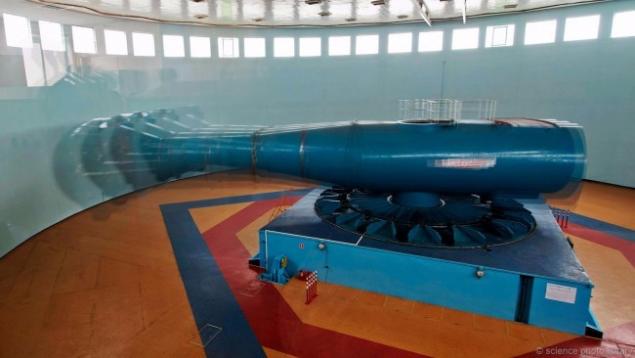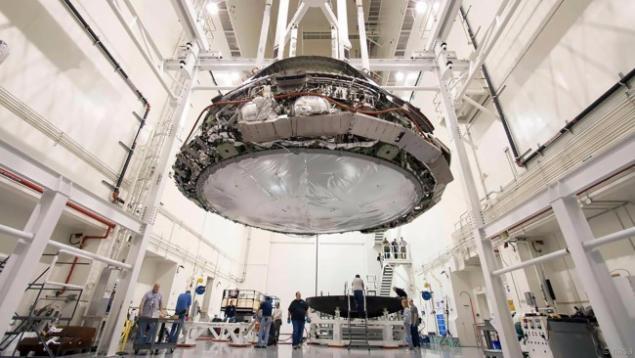709
How fast and safe can be space flight for humans?
We humans are obsessed with speed. Not long ago, news came out that students in Germany broke the record for the fastest electric vehicle and the US air force plans to develop hypersonic plane that can move five times faster than the speed of sound — faster 6100 km/h. These planes will carry people — but not because people can't travel with such high speed. In fact, people were already moving at a speed greater than 5 Mach. Is there some limit beyond which our body can no longer withstand the load speed? The current speed record held for 46 years. When he is beaten?

The current speed record, which was moving, belongs to the three astronauts of mission "Apollo-10". Returning to Earth after circling the moon in 1969, the capsule astronauts clocked up 24 790 km/h relative to the planet Earth. "I think a hundred years ago we could not imagine that people can move in space at a speed of almost 40 000 km/h," says Jim Bray from the aerospace company Lockheed Martin.
But this record, we can break relatively soon. Bray is the Director of the crew module project "Orion" for the American space Agency NASA. The spacecraft "Orion" is designed to transport astronauts to low Earth orbit and has a good chance of beating 46-year-old record for the fastest journey.
Space Launch System (SLS) new rocket that will carry the device "Orion" will make the first mission with the crew in 2012 — flyby of the asteroid captured in lunar orbit with a focus on multi-month mission to Mars in the near future. Currently designers present a typical maximum speed for "Orion" in 32 000 km/h But the speed record of "Apollo 10" may be surpassed, even if you adhere to the basic configuration of "Orion".
"Orion" is designed for many different purposes, its speed can be much higher than we plan now."And yet, even the Orion will not be able to submit our full high-speed capability. "There is no practical limit to the speed of our travel, unless the speed of light," says Bray. Light travels at a speed of a billion kilometers per hour. Will we be able to safely bridge the gap from 40 000 km/h to that speed?

To our surprise, the speed — i.e. the speed of the move — in itself is not a physical problem, remains relatively constant in one direction. In theory, people can only and can only in theory — travel at a speed slightly below the universal speed limit: the speed of light.
Assuming that we can overcome known limitations and tehnologicheskie to build a fast spacecraft, our fragile watery bodies will have to deal with new dangers that arise from such high speed travel. Possible dangers can appear, if people will master travel faster than the speed of light, having a terrific paradigm of open or finding loopholes in the current physical camp.
Struggle with congestion, If we accelerated to 40 000 km/h, acceleration should be gradual. Rapid acceleration and braking can be lethal to the human body: bodily injuries during road accidents appear during the instant of the fall speed of tens of kilometers per hour to zero in a split second. What is the reason? A property of the Universe, known as the inertia in which an object with mass resists change in motion state. This idea was expressed in the first Newton's law of motion: an object at rest remains at rest and an object in motion stays in motion with the same speed and in the same direction, while it is not affected by external forces.
"For the human body the consistency is good — explains Bray. — Experience is only about the acceleration."Roughly a century ago the invention of the aircraft, which can maneuver at speed, has led to the fact that the pilots began to report strange symptoms that accompany the changes of speed and direction. These included a temporary loss of vision and feeling of weightlessness or disorientation. The reason was G-force, the force of gravity, G. One G equals the pull of earth's gravity to the center of the planet, about 9.8 meters per second squared (at sea level).
G-forces exert influence vertically, from head to toe, or Vice versa, and it can be very uncomfortable for pilots and passengers. Blood in the legs, which influenced the force of gravity, flows to the head when we do the upright support. Eyes and eyelids bloodshot and trying to fall out of orbit. Conversely, when the acceleration is negative, the eyes and the brain lack of oxygen because the blood in the lower extremities. Leads to blurred vision becomes gray, then there can be total loss of vision, "blackout." High overload can lead to fainting, loss of consciousness, caused by congestion. A lot of pilots were killed due to the inability to see and the subsequent fall.

In such a centrifuge train pilots to fly
The average person can withstand a high overload in 5 G from head to toe, then cut off. The pilots, wearing special suits and trained to strain the muscles of your torso so that the blood flowed from his head too fast, can fly the plane at 9 G. "for short periods, the human body can withstand the load above 9 G says Jeff Sviontek, Executive Director of the Aerospace medical Association in Alexandria, Virginia. But to endure them for a long time can not all".
If on the very very short moments, we humans can endure the overload is much higher, especially uninjured. Record instantaneous overload belongs to Eli Beeding Jr., captain U.S. air force. He rode backwards on a sledge with a rocket engine in 1958 and took on his chest (literally) load of 82.6 G when the sled accelerated to 55 km/h a tenth of a second. Beeding crashed out but escaped with only bruises on the back, demonstrating the incredible capabilities of the body.
To spacedepending on the transport, the astronauts also experienced quite a high overload — from 3 to 8 during takeoff and reentry, respectively. These overloads are usually represented by the pressure of gravity from front to back, due to the reasonable practice of tying space travelers to the seat, the face oriented in the direction of motion. As soon as the machine picks up speed 26,000 km/h in orbit, the astronauts feel their speed is not more than the passengers of a commercial airliner.

And if G-forces are a particular problem for long-term missions, "Orion", small pebbles space — micrometeorites — may be. These stones the size of a grain moving with incredible destructive a speed of 300 000 km/h to protect the ship and crew, "Orion" has a protective outer layer with a thickness of 18-30 inches depending on space and other shielding and smart equipment. "We just need to keep in mind what angle can get micrometeorites," says Bray.
Micrometeorites are not the only obstacle for future space missions, when people get up to high speeds. In the process the Mars mission will have to solve other practical issues, including the question of the supply of the crew and increase the longevity of the lives of its members due to radiation exposure. The reduction in time traveling, however, can mitigate these problems, the sooner the better.
Space travel a new generation ofneed for speed will lead us to new obstacles. The latest NASA vessel that can break the land speed record "Apollo-10", will continue to rely on time-tested propulsion system of the chemical rockets used since the first space missions. But these systems have significant speed limitations due to the low amount of energy they release per unit of fuel.
So, in order to achieve higher speeds for sending humans to Mars and beyond, scientists are looking for new approaches. "The system that we have now are good enough to get us there, says Bray. But I would like to see a revolution in the field of jet propulsion".
Eric Davis, senior research fellow, Institute for advanced studies at Austin, describes the three most promising way is with the use of traditional physics — which will help mankind to achieve a decent interplanetary speeds. In short, these three phenomena with the release of energy: decay, fusion and annihilation of antimatter.
The first method is the splitting of atoms, as is done in commercial nuclear reactors. Second, synthesis, connects atoms into heavier atoms, this reaction powers the Sun and our hopes for the advent of thermonuclear fusion devices that are "always 50 years away".
"It's advanced technology, says Davis, but use traditional physics, and have proven themselves since the dawn of the atomic age". A variety of propulsion system on the basis of synthesis and disintegration of atoms can in theory the machine to disperse 10% of the speed of light — and this, sorry, 100 000 000 km/h. the Best way to disperse the spacecraft is antimatter, normal matter DoppelgangeR. When these two substances come into contact, they destroy each other out of pure energy. Today there are technologies for production and storage (albeit in meager amounts) of antimatter. But the production of antimatter in reasonable volumes requires costly plants of the next generation, and the design of the engine on the antimatter will be even more expensive. However, scientists are not sitting idle, and, as Davis says, on the drawing Board a lot of good projects.

With the engine out of antimatter, a spacecraft can accelerate in the months or years to a very high percent of the speed of light, keeping G at an acceptable level for passengers. But these fantastic speeds give rise to new dangers for the human body.
Energetic gradAt a speed of several hundred million miles per hour every speck of dust in the cosmos, from hydrogen atoms to micrometeorites, becomes a powerful bullet that is directed at the body of the device. "When you move at high speed, with the same high speed and the particle is moving towards you," says Arthur Edelstein dealing with the effects of the atoms of cosmic hydrogen on ultra-fast space travel.
One cubic centimeter in space there is about one atom, the cosmic hydrogen will turn into the intense bombardment of radiation. This hydrogen will flow into subatomic particles, which will pass through the ship, irradiating the crew and the equipment. At speed in 95% of the light, the exposure will be almost instantly fatal. The ship is heated up to the melting point of any conceivable material, and the water in the bodies of the crew members will immediately boil. "It's pretty nasty problems," caustically remarked Edelstein.
Together with his father, he calculated that in the absence of the hypothetical magnetic screen, which will reflect the full deadly hydrogen star ship can only move at half the speed of light, without endangering crew members.

Marc Millis, a physicist propulsion systems and the former head of the breakthrough physics program of NASA's jet propulsion, warns that such a potential limit of the speed of human movement remains a distant problem. "If based on already proven physics, speed of 10% of the light will be very difficult to achieve, he says. — Until we're safe. With such success we have to worry about the possibility of drowning when, even before the water has not yet reached".
Faster than lightlet's Say we learned to swim, to continue the analogy, can we ever conquer the waves of space-time and begin to travel with superluminal speed?
The enduring popularity of superluminal motion, which, although remains purely speculative, is not without flashes in the dark. One of the interesting scenarios superluminal motion includes a "warp drive" like that was in the TV series "Star trek". The so-called Alcubierre engine compresses the usual space-time described by Einstein's physics, in front of the spacecraft, expanding it behind. As a result, the ship remains in a piece of space-time — warp-bubble, the bubble deformation which moves faster than the speed of light. While the ship remains at rest in normal space-time, not breaking the fundamental limit of light speed.
What's the catch? This concept requires an exotic form of matter possessing negative mass to compress and expand space-time. "Physics does not forbid negative mass, — says Davis. But he doesn't know such examples and I have never seen it in nature." One catch: the work of scientists of the University of Sydney in 2012 showed that a warp bubble would gather cosmic particles high-energy, inevitably interacting with the contents of the Universe. Some particles can penetrate the bubble, showering the ship with radiation.
Doomed to run for the lightAre we forever stuck at sublight speed because of our fragile biology? From this response depends not only on the possibility of establishing a new human (or galactic) speed record, but the prospects for the formation of the interstellar community. At speed in the half light, where we have restricted Edelstein, travel to the nearest star will take 16 years.
But Millis is hopeful. Looking at how people invented costumes in order to cope with a high load of gravity, and micrometeorite shielding for safe travel at amazing speed, we can assume that we will develop ways to overcome speed barriers one by one.
"If technology will help to develop a hitherto unprecedented rate, if a future physics will find this technology possible, says Millis, will provide us with incredible opportunities to protect the crews."published
P. S. And remember, only by changing their consumption — together we change the world! ©
Source: hi-news.ru/space/naskolko-bystrym-i-bezopasnym-mozhet-byt-kosmicheskij-polet-dlya-lyudej.html

The current speed record, which was moving, belongs to the three astronauts of mission "Apollo-10". Returning to Earth after circling the moon in 1969, the capsule astronauts clocked up 24 790 km/h relative to the planet Earth. "I think a hundred years ago we could not imagine that people can move in space at a speed of almost 40 000 km/h," says Jim Bray from the aerospace company Lockheed Martin.
But this record, we can break relatively soon. Bray is the Director of the crew module project "Orion" for the American space Agency NASA. The spacecraft "Orion" is designed to transport astronauts to low Earth orbit and has a good chance of beating 46-year-old record for the fastest journey.
Space Launch System (SLS) new rocket that will carry the device "Orion" will make the first mission with the crew in 2012 — flyby of the asteroid captured in lunar orbit with a focus on multi-month mission to Mars in the near future. Currently designers present a typical maximum speed for "Orion" in 32 000 km/h But the speed record of "Apollo 10" may be surpassed, even if you adhere to the basic configuration of "Orion".
"Orion" is designed for many different purposes, its speed can be much higher than we plan now."And yet, even the Orion will not be able to submit our full high-speed capability. "There is no practical limit to the speed of our travel, unless the speed of light," says Bray. Light travels at a speed of a billion kilometers per hour. Will we be able to safely bridge the gap from 40 000 km/h to that speed?

To our surprise, the speed — i.e. the speed of the move — in itself is not a physical problem, remains relatively constant in one direction. In theory, people can only and can only in theory — travel at a speed slightly below the universal speed limit: the speed of light.
Assuming that we can overcome known limitations and tehnologicheskie to build a fast spacecraft, our fragile watery bodies will have to deal with new dangers that arise from such high speed travel. Possible dangers can appear, if people will master travel faster than the speed of light, having a terrific paradigm of open or finding loopholes in the current physical camp.
Struggle with congestion, If we accelerated to 40 000 km/h, acceleration should be gradual. Rapid acceleration and braking can be lethal to the human body: bodily injuries during road accidents appear during the instant of the fall speed of tens of kilometers per hour to zero in a split second. What is the reason? A property of the Universe, known as the inertia in which an object with mass resists change in motion state. This idea was expressed in the first Newton's law of motion: an object at rest remains at rest and an object in motion stays in motion with the same speed and in the same direction, while it is not affected by external forces.
"For the human body the consistency is good — explains Bray. — Experience is only about the acceleration."Roughly a century ago the invention of the aircraft, which can maneuver at speed, has led to the fact that the pilots began to report strange symptoms that accompany the changes of speed and direction. These included a temporary loss of vision and feeling of weightlessness or disorientation. The reason was G-force, the force of gravity, G. One G equals the pull of earth's gravity to the center of the planet, about 9.8 meters per second squared (at sea level).
G-forces exert influence vertically, from head to toe, or Vice versa, and it can be very uncomfortable for pilots and passengers. Blood in the legs, which influenced the force of gravity, flows to the head when we do the upright support. Eyes and eyelids bloodshot and trying to fall out of orbit. Conversely, when the acceleration is negative, the eyes and the brain lack of oxygen because the blood in the lower extremities. Leads to blurred vision becomes gray, then there can be total loss of vision, "blackout." High overload can lead to fainting, loss of consciousness, caused by congestion. A lot of pilots were killed due to the inability to see and the subsequent fall.

In such a centrifuge train pilots to fly
The average person can withstand a high overload in 5 G from head to toe, then cut off. The pilots, wearing special suits and trained to strain the muscles of your torso so that the blood flowed from his head too fast, can fly the plane at 9 G. "for short periods, the human body can withstand the load above 9 G says Jeff Sviontek, Executive Director of the Aerospace medical Association in Alexandria, Virginia. But to endure them for a long time can not all".
If on the very very short moments, we humans can endure the overload is much higher, especially uninjured. Record instantaneous overload belongs to Eli Beeding Jr., captain U.S. air force. He rode backwards on a sledge with a rocket engine in 1958 and took on his chest (literally) load of 82.6 G when the sled accelerated to 55 km/h a tenth of a second. Beeding crashed out but escaped with only bruises on the back, demonstrating the incredible capabilities of the body.
To spacedepending on the transport, the astronauts also experienced quite a high overload — from 3 to 8 during takeoff and reentry, respectively. These overloads are usually represented by the pressure of gravity from front to back, due to the reasonable practice of tying space travelers to the seat, the face oriented in the direction of motion. As soon as the machine picks up speed 26,000 km/h in orbit, the astronauts feel their speed is not more than the passengers of a commercial airliner.

And if G-forces are a particular problem for long-term missions, "Orion", small pebbles space — micrometeorites — may be. These stones the size of a grain moving with incredible destructive a speed of 300 000 km/h to protect the ship and crew, "Orion" has a protective outer layer with a thickness of 18-30 inches depending on space and other shielding and smart equipment. "We just need to keep in mind what angle can get micrometeorites," says Bray.
Micrometeorites are not the only obstacle for future space missions, when people get up to high speeds. In the process the Mars mission will have to solve other practical issues, including the question of the supply of the crew and increase the longevity of the lives of its members due to radiation exposure. The reduction in time traveling, however, can mitigate these problems, the sooner the better.
Space travel a new generation ofneed for speed will lead us to new obstacles. The latest NASA vessel that can break the land speed record "Apollo-10", will continue to rely on time-tested propulsion system of the chemical rockets used since the first space missions. But these systems have significant speed limitations due to the low amount of energy they release per unit of fuel.
So, in order to achieve higher speeds for sending humans to Mars and beyond, scientists are looking for new approaches. "The system that we have now are good enough to get us there, says Bray. But I would like to see a revolution in the field of jet propulsion".
Eric Davis, senior research fellow, Institute for advanced studies at Austin, describes the three most promising way is with the use of traditional physics — which will help mankind to achieve a decent interplanetary speeds. In short, these three phenomena with the release of energy: decay, fusion and annihilation of antimatter.
The first method is the splitting of atoms, as is done in commercial nuclear reactors. Second, synthesis, connects atoms into heavier atoms, this reaction powers the Sun and our hopes for the advent of thermonuclear fusion devices that are "always 50 years away".
"It's advanced technology, says Davis, but use traditional physics, and have proven themselves since the dawn of the atomic age". A variety of propulsion system on the basis of synthesis and disintegration of atoms can in theory the machine to disperse 10% of the speed of light — and this, sorry, 100 000 000 km/h. the Best way to disperse the spacecraft is antimatter, normal matter DoppelgangeR. When these two substances come into contact, they destroy each other out of pure energy. Today there are technologies for production and storage (albeit in meager amounts) of antimatter. But the production of antimatter in reasonable volumes requires costly plants of the next generation, and the design of the engine on the antimatter will be even more expensive. However, scientists are not sitting idle, and, as Davis says, on the drawing Board a lot of good projects.

With the engine out of antimatter, a spacecraft can accelerate in the months or years to a very high percent of the speed of light, keeping G at an acceptable level for passengers. But these fantastic speeds give rise to new dangers for the human body.
Energetic gradAt a speed of several hundred million miles per hour every speck of dust in the cosmos, from hydrogen atoms to micrometeorites, becomes a powerful bullet that is directed at the body of the device. "When you move at high speed, with the same high speed and the particle is moving towards you," says Arthur Edelstein dealing with the effects of the atoms of cosmic hydrogen on ultra-fast space travel.
One cubic centimeter in space there is about one atom, the cosmic hydrogen will turn into the intense bombardment of radiation. This hydrogen will flow into subatomic particles, which will pass through the ship, irradiating the crew and the equipment. At speed in 95% of the light, the exposure will be almost instantly fatal. The ship is heated up to the melting point of any conceivable material, and the water in the bodies of the crew members will immediately boil. "It's pretty nasty problems," caustically remarked Edelstein.
Together with his father, he calculated that in the absence of the hypothetical magnetic screen, which will reflect the full deadly hydrogen star ship can only move at half the speed of light, without endangering crew members.

Marc Millis, a physicist propulsion systems and the former head of the breakthrough physics program of NASA's jet propulsion, warns that such a potential limit of the speed of human movement remains a distant problem. "If based on already proven physics, speed of 10% of the light will be very difficult to achieve, he says. — Until we're safe. With such success we have to worry about the possibility of drowning when, even before the water has not yet reached".
Faster than lightlet's Say we learned to swim, to continue the analogy, can we ever conquer the waves of space-time and begin to travel with superluminal speed?
The enduring popularity of superluminal motion, which, although remains purely speculative, is not without flashes in the dark. One of the interesting scenarios superluminal motion includes a "warp drive" like that was in the TV series "Star trek". The so-called Alcubierre engine compresses the usual space-time described by Einstein's physics, in front of the spacecraft, expanding it behind. As a result, the ship remains in a piece of space-time — warp-bubble, the bubble deformation which moves faster than the speed of light. While the ship remains at rest in normal space-time, not breaking the fundamental limit of light speed.
What's the catch? This concept requires an exotic form of matter possessing negative mass to compress and expand space-time. "Physics does not forbid negative mass, — says Davis. But he doesn't know such examples and I have never seen it in nature." One catch: the work of scientists of the University of Sydney in 2012 showed that a warp bubble would gather cosmic particles high-energy, inevitably interacting with the contents of the Universe. Some particles can penetrate the bubble, showering the ship with radiation.
Doomed to run for the lightAre we forever stuck at sublight speed because of our fragile biology? From this response depends not only on the possibility of establishing a new human (or galactic) speed record, but the prospects for the formation of the interstellar community. At speed in the half light, where we have restricted Edelstein, travel to the nearest star will take 16 years.
But Millis is hopeful. Looking at how people invented costumes in order to cope with a high load of gravity, and micrometeorite shielding for safe travel at amazing speed, we can assume that we will develop ways to overcome speed barriers one by one.
"If technology will help to develop a hitherto unprecedented rate, if a future physics will find this technology possible, says Millis, will provide us with incredible opportunities to protect the crews."published
P. S. And remember, only by changing their consumption — together we change the world! ©
Source: hi-news.ru/space/naskolko-bystrym-i-bezopasnym-mozhet-byt-kosmicheskij-polet-dlya-lyudej.html
Dobrobut - reusable notebooks for ecologycally
In Britain will test wireless charging for electric vehicles on the go























